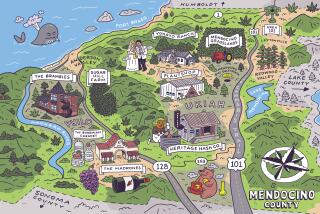Farmers Markets: Damson plums worth preserving
With dark blue, astringent skins, and dry, sour flesh, the ancient plums called damsons aren’t good for eating fresh. When submitted to a process akin to alchemy, however, their tartness and spiciness are ideal for making preserves. Cooked down, the damson’s astringency disappears, and its tannic skin imparts a gorgeous magenta color and rich, spicy flavor, while its abundant pectin confers a lusciously thick and smooth consistency.
Originating in western Asia (supposedly near Damascus, whence its name), the damson is considered by scientists to be an ancestor of the sweeter and larger European plums. It was present by ancient Roman times in England, where it has long been prized as the quintessential culinary plum. Damsons were most commonly grown in northwestern England, both as a fruit crop and for use as a dye in the wool industry. Because sugar was scarce during and after World War II, preserves became a luxury, and the cultivation of damsons greatly declined.
Damson trees were brought to California by the early 1850s and used for home canning and preserves. Damsons have never been much grown commercially here but have made a small comeback recently with the resurgence of interest in artisanal jams.
One passionate amateur preserves maker, Denise Bratton, an art and architectural historian and editor, has scoured the state from Santa Paula to Sebastopol, searching for damsons. She found that they are rare even at farmers markets and that professional damson preservers are loath to divulge their sources.
A few years ago she was delighted to find that Irene Burkart, 88, had five trees on the ranch she founded in 1963 in Dinuba and now operates with her son Richard. He sold some Damsons at farmers markets. They didn’t sell that well and the trees were getting old, so Richard started cutting them down. Three weeks ago, when Bratton visited the farm, she was shocked to find that only two remained, so she decided to buy the whole crop.
She waited there for the harvest, which was exceptionally heavy this year, and had another shock: She had just bought 225 pounds of damsons. She shared half with Kevin West, a former editor at W magazine who is now a master preserver. He writes a blog on preserving called Saving the Season and has written a book by the same title, forthcoming from Knopf in spring 2013.
For the next week Bratton cooked late into the night in her kitchen in Los Feliz, assisted by her housekeeper, working in small batches for best quality. When she finished she had 200 jars, a lot for someone who doesn’t eat much jam.
Current regulations require cooked foods sold to stores, restaurants and consumers to be prepared in commercial kitchens, so she can’t sell them. (The recent signing of AB 1616, the California Homemade Food Act, will allow such sales by home food producers registered with and inspected by local health departments, starting in January.)
So what will Bratton do with all that damson jam?
“This is going to be Christmas presents for everybody I know,” she said.
West cooked his damsons, also in small batches, in a commercial kitchen in Glendale. His smooth damson jam, lightly flavored with bay laurel (“a natural flavor match”) is available at Lindy & Grundy, Standard Goods, Domaine LA, and Atwater Village Farm for $12 for an 8-ounce jar, and by mail order through his blog site. West will conduct a tasting at Lindy & Grundy at 11 a.m. to 1 p.m. Saturday.
An earlier visit to June Taylor, the queen of California artisanal preserves makers, inspired West to use a few pounds of the Burkart fruit to prepare a trial batch of damson cheese, which he calls “one of the glories of the English preserving tradition.” Essentially a dehydrated jam, it is similar in style and texture to quince paste and is typically eaten with dairy cheese. It can be molded into intricate shapes and can be aged for five years or more while retaining its vibrancy, like a fine wine.
“It maintains its fruit but also develops darker, mysterious flavors,” said West.
For those who want to make their own damson preserves, finding fruit is tricky but not impossible. Most growers have just a few trees each, so it helps to reserve in advance. The harvest ranges from late August and early September in the San Joaquin Valley to late September in Oregon.
Aside from Burkart, who sells damsons at the Hollywood and Santa Monica farmers markets when his crop is not spoken for, growers include Greenberg Ranch (Bruce and Emily Greenberg) of Santa Paula, at the West Los Angeles farmers market; Blossom Bluff Orchards (Ted and Fran Loewen) of Parlier, at the San Francisco Ferry Plaza and Berkeley markets; Bera Ranch (Frank and Michelle Bera) of Vacaville, at the Napa, St. Helena and Vacaville markets; Hale’s Apple Farm (Dave and Jill Hale) of Sebastopol, at the Palo Alto and San Rafael markets; and Ayers Creek Farm (Anthony and Carol Boutard) of Gaston, Ore., at the Hillsdale market.
The damson, like the quince, may be so out that it’s in again. For their part, Bratton and West dearly hope that their efforts will inspire consumers to seek out damson preserves and persuade growers to plant more trees.
More to Read
Eat your way across L.A.
Get our weekly Tasting Notes newsletter for reviews, news and more.
You may occasionally receive promotional content from the Los Angeles Times.










